D'Addario XL (and EXL) Strings - Time Proven Favorites
This is an opinion review, not a religious or fan-boy review... This is an experienced view of a high-quality brand and string... I play MANY brands of strings, including D'Addario XLs - I believe my review presentation is objective...
As a musician, a guitar nut, and a recording artist, I'm always exploring different things to get different sounds. I'm always trying out strings, picks, pickups, electronics, and much more... always looking to see what something sounds like or feels like.
Strings are a fundamental of music with stringed instruments. Just as a stylus is important to the audio output quality of a fine phonograph, strings effect the sound quality of an instrument. Also, the
feel of strings is important to the way the musician interacts with their instrument. There are many, many things about strings that are very personal in nature...
So, what do we feel about our strings? It seems as though every musician with whom I speak has a completely different view of their strings. It's truly amazing. Musicians, from pro to novice, all express divergent views on their strings.
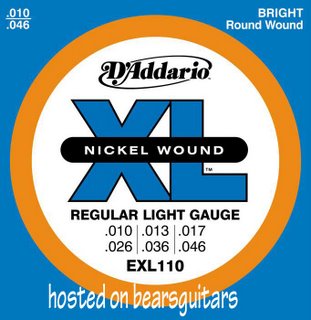
Some folks are so fanatic about their strings that they will spend long periods of time going through identical sets of strings to get just the perfect string or set or pairs or sets of strings. Yet there are others who have the attitude of "it doesn't matter to me, just make sure they're nickel-plated 10s" or "I guess I should change my strings - they're a year old now."
And yet others are somewhere in between. What's right? The right answer is, if the strings do what you want, then they're the right ones.
So, enough about the philosophy of strings... let's talk about a particular brand and type... I'll write more reviews about other brands and types down the road a bit. Today, I'm going to ramble about D'Addario XL strings.
Read more and get pricing information here at GuitarCenter.com
Briefly: I don't beat my strings, nor do I pick/pluck extremely hard or firmly. But, on the other hand, I don't have the light touch, either. Suffice it to say that I am somewhere in the middle when it comes to being hard on my strings. Also, I do like fresh strings - both from a cleanliness point of view and from a sound point of view. I change my strings when they feel icky or they begin to "darken" my instrument's sound. I don't like blackened rough strings or strings that are smelly and dull-sounding... with that in mind, let's do some exploration...
Quality:
First of all, I love these. They're super-consistent quality. I've opened, installed, and played hundreds of sets of D'Addario XL guitar and bass strings - and I've NEVER had one with a bend, a "funny place", or with a largely unreliable sound.
D'Addario strings, in general, are extremely consistent and extremely reliable. I've never had one break. I've never had one "go dull" on me before the rest of the set. I've never had one feel strange when I'm playing. The quality is good and consistent.
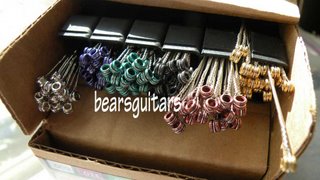 Sound:
Sound:
Here's one of the main things about strings... how do they sound? Not all strings are the same manufacture, not all strings sound the same, and not all strings are musical in the same way.
D'Addario XLs sound generally bright, whether you're playing nickel-plate, pure nickel, or acoustic brass/bronze strings. They have a nice growl to them that sounds like freshly wound metal - very nice. I've played strings from other manufacturers - strings bearing virtually the exact same specs as the XLs I've played. In general, the D'Addarios growl a little more, sing a little more, and produce a mellow tone when played easy on clean.
Value:
D'Addario XLs are generally priced within a half-dollar of all of its competitors. I don't feel that D'Addario XLs are expensive or cheap - they seem priced just right... I feel as though they are the "workhorse" type of string - a brand and type musicians can count on.
They're a great value and will please a large percentage of the string-instrument-playing population...
Long Lasting:
D'Addario XLs last a fairly long time. There are other brands and types I've used that stay close to "fresh" feel and sound longer than the XLs I play, but not many. I have also played brands (brands that I DO like, mind you) that don't last nearly as long.
In general, D'Addario XLs seem to last well past average, and are consistently in the top range of long-lasting uncoated strings.
Closing opinion:
I love D'Addarios. I install them on customer's guitars very frequently. I have a couple of guitars that get nothing but D'Addario XLs (generally 10s). I REALLY like the phosphor-bronze sets I use on my Ibanez acoustic.
I love the quality and the general sound of them. I like the multi-pack options to save some coin, and I like the way they feel even up to the time when they start to get grimy.
They're great strings. Give them a try.
Labels: acoustic guitar, bass guitar, Bass Strings, D'Addario, electric guitar, great sounding, Guitar Strings, high quality, long lasting, strings, XL110, Xl120
Dean Vendetta XM Electric Guitar Review
Some guitars have a dual purpose in their useful lives. The Dean Vendetta XM guitar is just such a wonder. Some folks need an inexpensive guitar to get them started - not everyone can afford a $2200 Les Paul Standard or a $1300 Fender Deluxe Stratocaster. Some folks need a decent instrument as a base (donor) for some seriously fun modifications - without having to spend $600 on aftermarket parts to put together a donor instrument for one's ideas.
Low-cost guitars tend to fall into one of three categories: cheap, and built to play that way; inexpensive, but not a hit in any area (GREAT specs but poor execution); and inexpensive - but more value than the dollars spent. The Dean Vendetta falls into the third category. As with all low-end/beginner guitars, there are obvious places in the Vendetta XM where money has been saved. Still, the build quality is fine, and the features are actually wonderful.
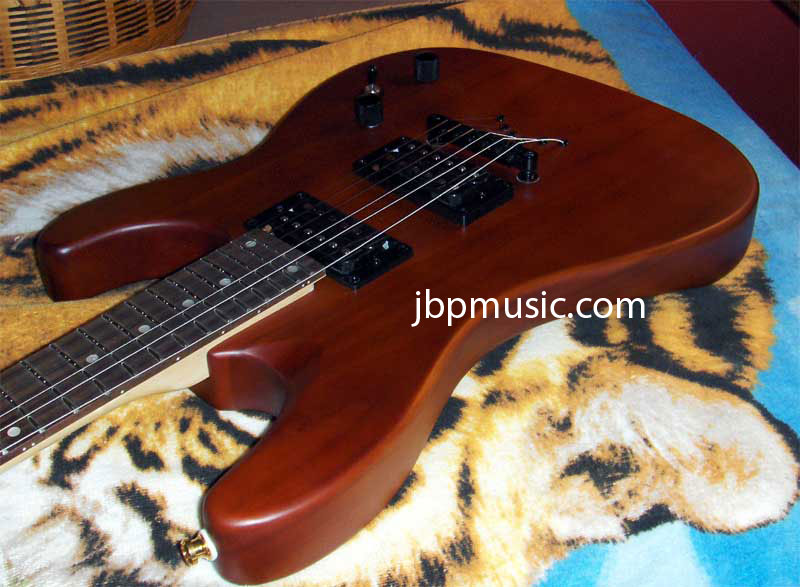
I specifically went out looking for a Stratocaster-shaped guitar for a mini-humbucker project I had in mind. I didn't want an actual Strat (or Strat clone) this time: I was looking for double cutaway, light weight, and an interesting neck. The Dean Vendetta XM went on sale at my local Guitar Center (and is on sale at Musician's Friend) - perfect timing. I had some proceeds from a guitar sale at Christmas time - and the Vendetta XM came home with me post-haste. It has been the perfect donor guitar for the creation of an AWESOME double mini-humbucker project with a 5-way rotary selector. With some nice USA-made parts, high-end import parts, mods, and a little time, it turned out to be an absolute gas!
Let's talk about the factory Vendetta XM with which I started, pre-mods.
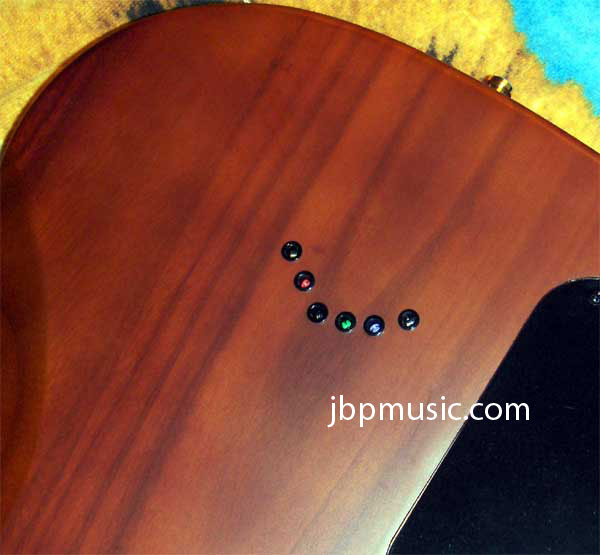 Quick Opinion:
Quick Opinion: The Dean Vendetta XM is a good beginner's guitar - one well-suited to folks who have not yet begun to grow into their inner guitar-hero-self. As with any beginner's instrument, the Vendetta XM is not comparable to well-made instruments from the United States or Japan. If one doesn't expect high-end guitar-ness in the Vendetta XM's $100 form, one will be OK with the result. No, the Vendetta XM is not an American Standard Stratocaster. No, the Vendetta XM is not a USA-made Dean for the family heirloom closet. The Dean Vendetta XM is a nice-looking, great-playing instrument for beginners. It is lightweight, well-featured, and actually looks different than most beginner guitars.
I think the Dean Vendetta XM is a great guitar for starters - one that can be upgraded to accommodate the growing needs of a burgeoning guitar player. This guitar is particularly good for smaller folks (who still want a full-size guitar), or for those that don't like lots of weight hanging on their guitar strap.
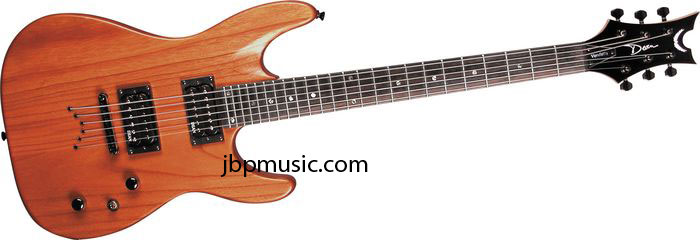
My Dean Vendetta XM was not very well set up when I got it. There were (more than usual for a beginner's instrument) fret buzzes and the strings were set too high for a beginner. The intonation is pretty close for a bargain guitar. However, nearly every inexpensive instrument I have ever played had some setup or adjustment issues when pulled out of its box. On the positive side - my Vendetta XM came with an arrow-straight neck and VERY unusually excellent soldering in the control cavity.
Free Shipping, more information, and pricing for Dean Vendetta XM models here at GuitarCenter.com Features:
Features: The Dean Vendetta XM's features are very much it's strongest point. The guitar has a string-through design across a Tune-O-Matic-style non-trem bridge - and the sustain and ring of the body definitely shine through. Even the acoustic sound of the Vendetta XM is pretty good. The string-through design makes for great "ring", reasonable low-end frequencies, and an interesting look to boot.
The simple control layout is a plus. One master tone, one master volume, and a three-way toggle switch adorn the Vendetta XM. The toggle selections are: neck humbucker, both humbuckers, and bridge humbucker. The toggle is a little close to the volume knobs (for quick-change switch slapping while playing). An inspection of the inside of the control cavity was surprising: the soldering was excellent, clean, and well-done. The anti-noise shielding black paint, however, was terribly applied (nothing a little copper shielding won't fix).
The body is very lightweight and is a comfort to the shoulder. The guitar is a little neck-heavy because of the light body, but it isn't obnoxious. My suede strap (fuzzy on the shoulder-side) holds my Vendetta XM pretty well in place for long periods. One small sacrifice of the light body: the guitar doesn't have quite as much sonic guts as a heavyweight like an Epiphone Les Paul, PRS SE, or Squier HH Stratocaster. The stock pickups and the light body do make for some relatively warm (but slightly mushy) sounds played through some amplifiers or models. This is an important thing: the guitar is Extremely comfortable; but there is a small price. A beginner would not feel the sonic difference early in her/his experience. But, this can be fixed with good pickups, a decent nut, and some good adjustment.
Overall, the neck is well above par for an inexpensive instrument. It is reminiscent of a nice Jackson or even a wider Epiphone neck. I like the feel and playability of maple on the back. The rosewood of the neck was kind of weird though: the factory had applied excessive "fingerboard black" to the rosewood. My fingers are black every time I play my Vendetta XM. My particular Vendetta has a great, straight neck. It does, however, have a rough feel - the finish had not been polished down/sanded well enough.
The tuners are adequate sealed machine heads that work fine. Strong bending does pull the instrument out of tune - but not any more or less than any other bargain guitar. The tuners are, however, smooth, better-than-average, and look a lot like the Schaller-type tuners on the nicer Squier instruments.
The dual humbuckers are average, and do the job well enough for a beginner instrument. As with any low-cost humbucker instrument, the humbuckers don't sound like BurstBuckers, DiMarzios, or Seymour Duncan SH* pickups. They're exceptionally easy to replace as the beginner becomes more desirous of better sound. Overall, the sound is fine and the quality is better than average.
My Vendetta XM came fitted with nice lightweight D'Addario strings. They were in good condition, were well-selected for the neck and body type. It's a refreshing change to see commercial-grade strings on a basic instrument - most instruments on the market have lowest-bidder strings installed at the factory.
 Quality:
Quality: The quality of my Dean Vendetta XM is a mixed bag. The finish of the body is flawless - even, smooth, consistent, and attractive (no, they're not gloss finished like in most pictures you'll see - they're satin finished). The finish on the neck is in need of work. The neck finish was rough, the frets were a bit unfinished, and the fretboard is just not as nice as it should be. Even the imprint of the serial number is poorly done. The neck finishing seems as if it was done in a big hurry. The nut is a hollow plastic variety - although this is not unusual in this price range, I'd expect more from Dean.
The wiring and electronics are way above average for a $100 instrument. The quality of the electronic components in my Vendetta were average to above average. The switch and pots are not high quality like Switchcraft USA switches/jacks or CTS pots, but they are adequate and will last for a good while. As with most any budget instrument, the electronics will be noisy in a few years.
I have to say this again (because it is VERY unusual): The electronics were very well done. Most high-end instruments I've played have the same level of soldering craftsmanship and wiring-lengths/wrapping. It may have been just my particular instrument, but I suspect that the simplicity of the controls and the large control cavity make for an easy job at the factory.
Playability: The Dean Vendetta XM is a very playable instrument. It is comfortable from a strap and body-fit perspective, and the neck is a good balance for large hands or even some smaller hands. It is smooth and comfortable in almost every respect.
The tuners go out of tune when the instrument is played aggressively, but not much more than any other beginner's instrument I've played. The instrument needs a reasonable set up when it is purchased - if nothing else to set the string height to the player's liking.
Value: The Dean Vendetta XM is a $149 value, usually sold for $110 to $99 street. Overall, it is a bargain. I really like Dean guitars, and I think they are the spice of the guitar store. I did not hesitate at all to purchase my Vendetta XM.
I think Vendetta XM is great for beginners, and mine has definitely made an excellent choice for my modifications!
Wishes: Do a better job with the neck, Dean: please?
Labels: dean, electric guitar, humbucker, humbuckers, review, vendetta, vendetta xm review
Peterson Tuners StroboSoft Tuning Software Review
I record many different types of music via my computer. I use guitars, basses, keyboards, and mic-recorded vocals and acoustic sounds/instruments. I am constantly in need of a tuner which keeps me from having to worry about intonation issues.
Guitars (the whole family, basses, 6-strings, 7-strings, exotics) and just about every stringed instrument are not
well-tempered.
Read about instrument tempering here. It's fascinating - opens new window. Sometimes, just tuning your instrument to the exact correct chromatic pitches isn't going to give you better sound - "in tune", yes, better sound, no. I've fought the tunings of my guitars for ages (particularly acoustics). Tune up to the correct notes, play three different tracks together with the exact same instrument and the exact same tuning - sometimes the three tracks played together don't sound too good. Why? Tempering. Lack of sweetening.
If you want to tune to the exact pitches your instrument plays, then the StroboSoft sofware (and Peterson's peerless hardware tuners) will give you just what you want, down to the cent (a cent is effectively a hundredth of a tone). But, some technologies help you by giving you "sweetened tunings" - these tunings include the famous and wonderful Buzz Felten tuning system sweetening settings. There are other excellent tunings available to warm and broaden your harmonic and melodic sounds. With StroboSoft, you can spend your time with your music, not with fiddling with your tuner for hours on end.
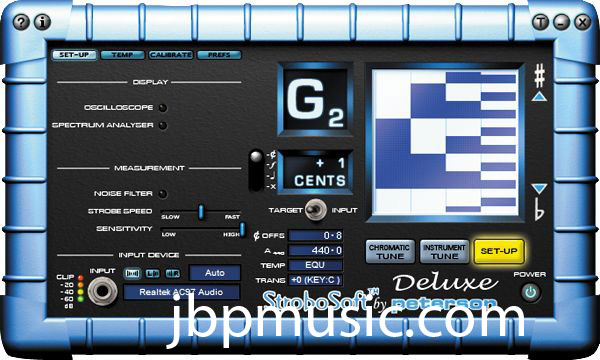
Peterson's hardware strobe tuners are the best of the best of the best. I've been interacting with them since I was in school band back in the seventies. Recent Peterson Tuners for guitar, bass and other stringed instruments include sweetened tunings. StroboSoft Deluxe also includes sweetened tunings - all of which work
WONDERS for your music and your ears!
Free Shipping and more information for Peterson StroboSoft
If you'd like to read more about StroboSoft in detail, you can visit the StroboSoft site here:
StroboSoft.
Quick Opinion: Buy this piece of software. Buy this piece of software. Buy this piece of software. Really: Buy this piece of software. Your music will sound better, your music will flow better, you'll have more time to work on your music...
If you're gigging, playing outside a studio, or on the road - invest in a hardware Peterson Tuner (and take StroboSoft's capability with you). The hardware tuners are more expensive than the average hardware tuner, but they are worth it. At some point, I'm going to save up enough sheckels and buy a StroboStomp or the rack version for myself... Their hardware is well worth twice (or more) than their current street prices.
If I can get my paws on a Peterson hardware tuner in the near future, I will write an extensive review of it, as well.
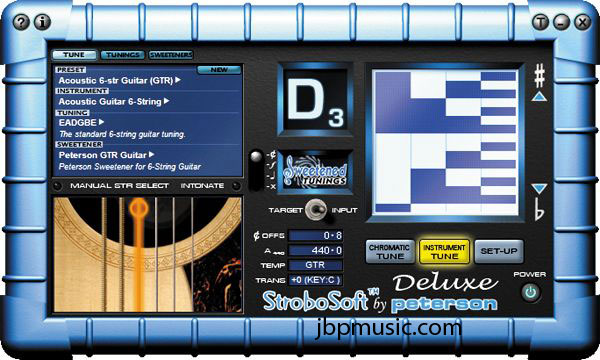 Features:
Features: StroboSoft is a snap to use. Install it, go to the setup tab, select your instrument input hardward device, click on "Instrument tune", then choose what kind of tuning you want (6 String electric? 6 String Acoustic? Sweetened? 5 String Bass?). Pluck your strings, and work your tuners/slides/instrument tuning device until the strobe stops moving up or down. You're done.
Set up for the first time takes very little time. Just take a few minutes to read their introduction, set it up, and GO. YOUR music will be sweeter, warmer, and more natural-sounding in a few minutes. Be sure to check out and set up the noise canceling feature (so it can tune easier, even on a noisy guitar or mic) - once you're up and running and understand what the tuner's doing.
Quality: I have had no issues whatsoever with StroboSoft on any of the three computers I use for recording. It has never crashed, misbehaved, or given me the first issue. Flawless.
In case you're wondering, this review is glowing because the product
REALLY deserves it - not because of any other factor.
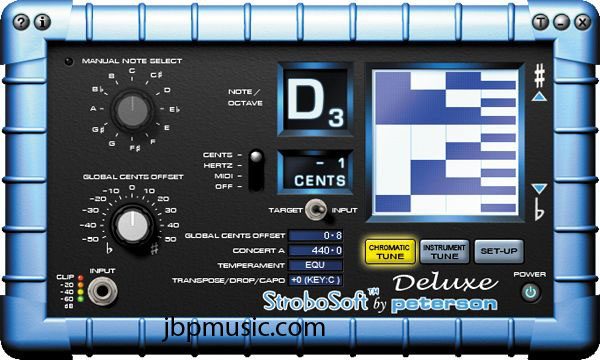 Value:
Value: In my opinion, this software is worth at least as much as Peterson Tuners' StroboFlip and StroboStomp hardware. I'm very impressed (and, frankly very, very happy) that it costs so little. The forums get answered, the emails get answered, the folks at Peterson care about their customers, and you cannot find a better value on the market.
Period.
Wishes: I'd love to see a Mac OSX dashboard widget interface to StroboSoft... just a thought...
Labels: 4 string bass, acoustic bass, acoustic guitar, computer recording, electric guitar, jimmy pearson, macintosh, osx, peterson, software, strobosoft, tuner, tuning, violin, vista, windows, xp
ESP LTD M-100FM/M-100/M100FM Review
Sometimes a guitar player just needs the rock-solid tuning of a locking nut combined with either a Floyd Rose tremolo or a Licensed Floyd Rose tremolo. With these little combinations of metal strapped to your axe, you can pull and push to your heart's content – and the guitar stays pretty much in tune.
Also, I'm a guitar nut. I like most guitars and guitar shapes (haven't warmed up to the angular and heavy-handed BC Rich stuff, yet). One of my functional favorites is the venerable Stratocaster shape. There's only one Strat, but it has spawned many different (and very similar) guitar shapes over the years. It would be really nice to have an affordable (read: not $399-$500) Stratocaster with a locking nut and Floyd Rose. One can purchase Fender's version of the Floyd on older, (USA- and Japanese-made) Strats. However, they do tend to bring fairly good prices (lots of folks want a Strat with a Floyd). Bear in mind that I am not comparing, nor will I in the near future attempt to compare a Fender to an ESP in my reviews. I am just using the Fender as a point of common reference.
So what are our alternatives? There are a few in the sub-$300 market, but not many.
One such alternative is the ESP LTD M-100. The current iteration, the M-100FM (flamed maple), is a wonderful choice and an excellent intermediate guitar. (Although my son is an advanced player, this guitar is actually one of his favorites, so don’t let the "intermediate" term fool you.)
The M-100 also makes for an excellent modifiable instrument – one that can be bent to the player’s needs in a great many way. I REALLY like this instrument (and hope to buy one someday). I think most players who seek great tremolo work and locking tuning will find this instrument to be top-notch at a low price!
Free Shipping and more information/pricing can be found here at GuitarCenter.com Quick Opinion:
Quick Opinion: In a few short words? If you want a Floyd, a locking nut, a comfortable Strat-type shape, and awesome build quality, the M-100FM is a bargain and a dream to play.
Buy one. I bought one for my son (Awesome!), and I will buy one for myself at some point in the future. ESP, you are on my list of favorites now.
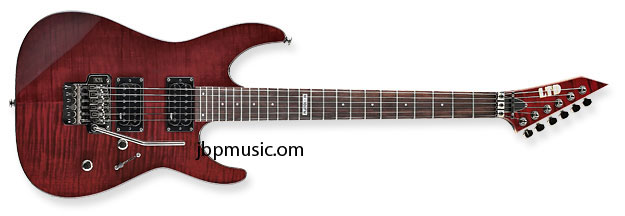 Modding:
Modding: The M-100FM uses a 3-position blade switch. With this type of switch slot and a two-humbucker configuration, the guitar just screams for some interesting pickup combinations! If 4-wire/coil-tappable pickups are installed after purchase, and a Fender 5-way super-switch (also a nice one from DiMarzio with the same blade type and connection terminals) – you can get the standard three positions of humbuckers, plus two different coil taps. Awesome sounding, flexible, no cutting or permanent modifications required.
I like the LH-150 open-face pickups that came in the guitar – for the money, they sound fine and have a broad range of harmonics for heavier music, pinch harmonics/pinch squeals, and other high-gain effects. However, the pickups are easily upgradeable to some pretty spectacular options. Some DiMarzio humbuckers, Seymour Duncan Humbuckers, and even some Gibson humbuckers make for great replacements for tailoring sounds to your needs. If you want to go for the coil-tapping modification, modern DiMarzios and Seymours are already 4-lead. You can get a professional to turn your 2-lead Gibson/Epiphone pickup to a 4-lead for a minimal amount of money: Imagine a coil-tappable, Gibson PAF sound in a Floyd Rose-enabled comfortable double cutaway guitar! Some of the above pickup choices may make it such that the poles don't quite line up with the strings, but the differences in sound make the offsets quite forgivable.
We modded my son's M-100FM with a fairly hot GFS PAF on the neck position and a really awesome Gibson 490T from a 2002 SG – both with chrome/nickel covers. It looks good and sounds fantastic.
Playability: Once strings are installed and tuned, the playability is excellent. The neck is of the slightly thin variety (not paper thin like a Randy Rhodes, but thinner than the average Epiphone or Fender Stratocaster). Access to all 24 frets is a breeze, with the 5th and 6th strings being a bit difficult (as is always true with this particular body design type). The relatively flat profile is consistently-done and is quite comfortable.
I really like the weight and balance of the guitar. The body is light and is generally equally balanced to the maple-and rosewood fretboard. When I use one of my nice 2" guitar straps with my son's M-100FM, I can play for hours before I start to feel the guitar's weight. Although the sound is not relative to a Les Paul/Firebird/Explorer’s heavy-body ever-lasting sustains, there is a great balance between weight and sustain.
The Licensed Floyd Rose tremolo works like a charm, is comfortable, and does its job with great aplomb. I added a fourth spring to the tremolo claw to help with keeping the trem unit flatter to the body. Since my son plays harder and thicker strings, the tremolo tended to pull up too much with just three springs. As a result, the trem does take more effort, but it is also more controllable and less wobbly when doing finely actuated whammies.
 Features:
Features: The ESP LTD M-100FM guitar is a simple guitar – as most of this variety are. But don’t let the simplicity fool you.
The bolt-on neck is great, the two-humbucker and 3-way blade switch combination are excellent, and the licensed Floyd Rose trem system and locking nut are flawlessly executed.
Unlike some cheaper copies of this type of guitar, the M-100 has a counter-sink cut in the tail of the body to accommodate "pulling up on the whammy" in a significant way. This is not a guitar that has just had a Floyd bolted on for the sake of the feature alone. The set-up is excellent.
The body coating is a durable urethane/clear finish over a quilted (cap?) body with dark red or black stain underneath. The effect is beautiful – particularly with the spartan switch-and-two-knob configuration. The knobs are the simple, non-tapping, 1 tone and 1 volume variety.
I love the reversed headstock (longer low strings, shorter high strings). The tuners are fine and seem to be fairly precise, and the look is neat and attractive.
Quality: My son's M-100FM is very well-made so far as finish and fit are concerned. The clearcoat-on-stain is a mile deep in looks, and is glossier than fresh black glass. The neck is consistent, well-shaped, and fits to the body like a glove.
Like many Korean (and other southeast-Asian) manufactures, the wiring and soldering isn’t as nice as the American stuff. The potentiometers are fairly cheap, too. There is only a minimal amount of shielding present in the body and covers. Some simple ROHS-compliant spray or metal linings would be great (and not too expensive to execute, I'd wager).
I love the way this guitar is put together. Very easy to expand, and most of everything is fairly accessible underneath the pickups and in the rear cavities (trem box and controls box).
Sound: The standard pups sound quite good (well above average for a guitar in this price range that has so many other features – pickups in most less expensive guitars are usually sacrificed along with cheap tuners - this one's pretty good). The bolt-on neck is well-executed, so the sustainability is very good.
Overall, I like the way this guitar sounds at this price point.. If I were on an extremely limited budget and could not afford to mod this guitar, I would find that it would be perfect for heavier, overdriven, and/or distorted music. If you drop it through an all-tube, class-A amplifier with some serious watts, you'll need better pickups.
Value: This guitar has a street value of about $279. Interestingly enough, VERY few of them come on the secondary used market (like eBay, Craigslist, and such). It appears that most people find their M-100FMs to be real keepers!
In my opinion, this guitar could easily be sold at a street price of $329, so I think it is a great value. These are great guitars as primary dive-bombers or as a great guitar library member – well worth the money and well worth keeping.
Wishes: More colors, please - perhaps white or antique white? Also, I'd like the option of a maple fretboard (WOW. A transparent black flamed-maple body or transparent antique white with a maple fretboard would absolutely ROCK!).
ESP, I NEED ONE OF THESE! (Hint hint hint hint hint hint) I like the red or the black just fine, thanks! ;-) Are you folks listening? :-)
Labels: electric guitar, esp, flamed maple, floyd, floyd rose, humbuckers, jimmy bear pearson, licensed floyd rose, ltd, M-100, M-100FM, M100, M100FM, review, rose, tremolo, whammy
Gibson Faded SG Electric Guitar Review
Gibson USA Faded SG Review
Gibson has some awesome 6-string hard-body electric guitars. Les Paul, Explorer, Vee, Firebird, and SG. My favorite Gibson? Any Gibson.
The Gibson USA Faded SG reminds me of some of the SGs I played in the early 1970s (sans shiny finish, though). VERY lightweight, mahogany, thin neck, bright rockin’ humbuckers, tulip tuners, fixed bridge, and tons of vibe. Every time you pick it up, you don’t want to put it down. Gibson has brought these things back in a modern-day form.
Free Shipping and more information about the Gibson USA Faded SG at GuitarCenter.com Quick Opinion:
Quick Opinion: Like the Gibson Vintage Mahogany Les Paul, grab one. They’ll be gone and you will have missed a great instrument. This is the kind that will sell (30 years from now) on eBay for good bits of money because of the “vibe” and “mojo” of the lightweight, plain SG.
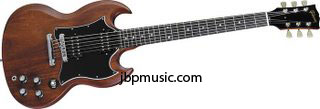 Playability:
Playability: The experience of playing the faded Gibson SG is a treat. The body is very nicely balanced, very comfortable, and vibrant.
The neck gives a sense of ease – where some necks make you think about them as you play, the neck on the faded SG is effortless such that you forget about it entirely. For you thick-neck fans, this will be an adjustment – it is quite slender and thin. It feels good, and doesn’t have the roughness of many of Gibson’s “faded” guitars.
The body is comfortable, and makes itself comfortable up against your picking arm and your ribcage. The body is very light-weight, almost the lightest solid-body I’ve ever picked up. Incredibly, though, the balance of body to neck is just about 50/50.
I’ve found that the (fairly standard) setup of the bridge, stop-tail, and nut feel good, and are quite flexible. I’ve played one that was set up for slide – strings high, but still playable with fingers. I’ve played several others that were set up for easy action and quick fingering. In both cases, the guitar performed flawlessly with no buzzes or flat spots. (A few of the fret wires had fuzzy ends, but nothing that couldn’t be handled with some fret polishing paper and a little TLC.)
Features: The features of the Gibson faded SG are basic, simple, and uncomplicated. The instrument features a standard 4-knob control: neck pickup tone and volume plus bridge pickup tone and volume. This SG also has the three-way toggle pickup selector (neck, neck and bridge, bridge).
The finish is sort of a satin clear finish on brown or cherry-looking mahogany. Unlike the faded Les Pauls and faded double-cutaway Les Pauls I’ve played recently, the finish on the SG is still smooth, even though it is not gloss-polished. The faded SG feels like an old, comfortable, worn guitar friend.
This instrument is ideal for a double-humbucker split-coil plus phase modification. (Just remember! Keep all the original stuff untouched! The original stuff is pretty sweet. Future generations will appreciate an elderly instrument with its original bits.)
I like the original-style Kluson tulip/keystone green “Deluxe” tuners. They’re not the sturdiest tuners out there – but they feel like the old Gibsons I’ve played as a kid.
Sound: Simply put, this SG SINGS. When you strike a chord or pluck a low string, you can FEEL the sound. It feels like it was special tuned for its setup, strings, and woods. The set neck, unfettered mahogany, and stop-tail bridge give this guitar a VOICE.
It can be played overdriven, over-distorted, clean, reverb-y, warm and jazzy, and lots more. I’ve played several examples at my local guitar stores (I can’t purchase one at the moment – starving artist – so I researched my review with many months of “research playing” at my guitar stores) – and I’ve played them through Mesa, Peavey, Epiphone, Marshall, Fender, Crate, and others. Standing in front of a full Marshall stack (tube head), with everything on 5 and volume on about 4 – WOW – it makes every guitar player in the store salivate to hear the sound.
The Gibson USA 490R and 490T pickups are flexible and warm, but have more output than the vintage SGs around which I grew up. They’re bright without being harsh. They’re easy to push into breakup with a good amp, and they play clean/jazzy with abandon. They’re fabulous.
Value: These SGs are very much worth their street price, maybe more. They’ve been marked down from the $700 range to the $579 range in the past few months. At the new price, they are very much a bargain.
Bear in mind: these do not come with a hard case at this price. They ship with a Gibson gig bag. If you want to preserve your SG, the genuine Gibson SG case (about $129 street) is well worth every cent. If you can’t swing that, at least find a durable TKL or SKG case for it.
As I said with the Vintage Mahogany Les Paul, go to your favorite get-in-trouble guitar store and play an example or two. If you don’t have a git-box store nearby, check out your favorite online haunt and pick one up NOW.
 Wishes:
Wishes: I only have two simple wishes: I wish they came with a Gibson hard-shell case (I personally think every Gibson deserves to live in a Gibson case). I also wish that the 490 pickups in this guitar came with German nickel humbucker covers. I’m spoiled by the looks of the old ‘70s SGs.
P.S. Gibson, if ever there was a Gibson sponsorship for "really great Bears who review guitars", this would definitely be one of the ones! wink wink wink nudge nudge
Labels: bear, electric guitar, epiphone sg, Faded, gibson, review
The Epiphone SG Special Review
Epiphone SG Special Electric Guitar Review
Bargain instruments are prolific in the modern instrument-sales market. There are large numbers of manufacturers, and there are a huge range of choices for the consumer. Generally, the competition and diversity of designs give consumers a wide range of choices for getting started with electric guitars.
About two years ago, my son wanted to go from using one of my instruments to having a guitar of his own. We talked about what kind of music he was enjoying the most, and what he liked in guitars. I played a fair number of beginner’s guitars (in the less-than-$150 range), showed him several pictures online, and took him to the guitar store a few times to play a range of different instruments. He settled on the venerable Epiphone SG Special (sometimes called the
Epiphone SG Special II because of its dual humbuckers.)
It was an excellent choice – one that is still serving him well two years later. He still enjoys it, and I enjoy borrowing it from him from time to time.
Quick Opinion: The Epiphone SG Special is very light, well-balanced, and has respectable sound. It has reasonable intonation capabilities, and the craftsmanship is at or above par for instruments in its price range.
As an all-around instrument, the SG Special competes very well on quality, price, features, and looks. This is a high-value instrument that is very reasonably priced.
Free Shipping and more information about the Epiphone SG Special II at GuitarCenter.com Playability:
Playability: Playability is the Epiphone SG Special’s strongest suit, next to its price.
The neck is typical Epiphone, slim but substantial, smooth painted, and medium width. It is a shallow “C” profile (in my opinion). It is very easy to access the entire fretboard with this guitar, largely due to its faithful rendition of the classic SG body design.
Whether you like your strings high up (for slide playing, and those with extremely strong hands), or your strings low – this neck serves very well. The frets are a little thin for my tastes, but they do get the job done in a reasonable way.
The balance of neck to body is excellent, particularly when standing and using a strap. The guitar is light and airy in the hands, but is
surprisingly resonant when it is played. I was amazed at how much the body rings with the notes. The light, thin guitar body is unobtrusive to the player’s picking arm, although it is not contoured for ribcage and pick arm rest.
The SG Special came fairly well set up from the factory. The frets were average-dressed for a guitar in this price range. There weren’t, however, any truly bad frets, sharp edges, or major string buzzers (a few spots on the neck, but MUCH less than the typical bargain-priced guitar).
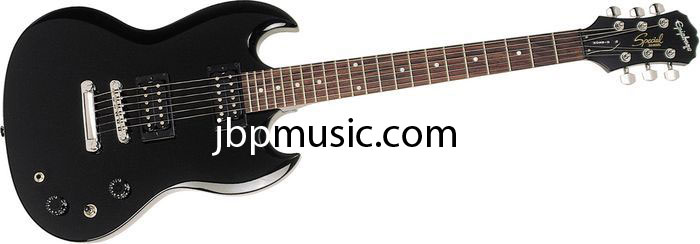 Features:
Features: The Epiphone SG Special electric guitar is almost par for features in its price range. It is thoroughly average, and has some things that outweigh others in terms of their value.
The body is great. SGs are fun and easy to play, and are a great all-around choice. The neck is a bolt-on affair, with a shallow pocket in the body to accept the heel of the neck. The feel of the neck and the feel/balance of the body are the strongest positives for the SG Special’s feature list. These items, coupled with this guitar’s sound, make the SG Special a good choice for most beginners.
The tuners are below average in quality. Most Squiers come with much better tuners. However, many bargain manufacturers use the same type of tuners (maybe even the same manufacturer? Not sure, they look the same, though). I think this was the first thing we did to mod the SG… we put Grover Rotomatics on, tuned up some new strings, and have seen significantly better tuning stability and accuracy. The Grovers made it much easier to do alternate tunings with thicker strings… the OEM tuners did not hold up well with rock-style thicker strings.
The SG Special has two potentiometer knobs, one for tone on both pickups, one volume for both pickups. The pickup selector switch allows the player to choose neck only (Rhythm), both pickups (a little more punchy and a little louder), and bridge only (Lead) for more clarity, growliness, and grind. The neck pickup is best suited for smooth sounds. The bridge is fairly hot/loud, and serves rock styles very well. The pickups are average in quality for this price range, perhaps a little more than average. They are largely quiet, and are the open-face (no cover) variety.
The pickups are easily adjusted with standard screw setups. The frets are a little on thin and shallow side, but work adequately well in the lower positions of the neck. Towards the body, the frets are a little small for my tastes – I like seeing taller frets for cleaner high notes.
Sound: The Epiphone SG Special sounds great through a nice amplifier. It holds up surprisingly well against guitars that can cost almost twice as much.
Although the pickups certainly aren’t on par with Gibson high output humbuckers or Seymour Duncan humbuckers, they are actually quite nice for a $150 guitar. The stock pickups can do the distortion thing pretty well, and can even pick up enough signal for pinch squeals and slap-plucks. The output of these pickups is pretty good, if not above average. They lack the smoothness and dynamic capability of better pickups – but they do well for beginners.
I was able to set the intonation of this instrument to very nearly ideal. The neck/length/scale is good for basic set up, but isn’t quite perfect. However, I’ve seen bargain instruments that don’t even come close to the SG Special’s tune-ability.
Value: Brand new, out of the box, the SG Special was ready to be played. I just tweaked the intonation and string height at the bridge, tuned it up, and it was ready to go. The SG has simplified tone and volume controls, and is very easy on the hands… Given the overall quality of the instrument, and the sound it makes, this is an instrument that is in the $189 range for
street value - one that you can get for significantly less at your favorite brick-and-mortar vendor or local guitar store establishment.
Overall, the SG Special II is a bargain – one that will last a beginning guitarist for a decent amount of time.
Wishes: I do think this instrument could use two volume and two tone controls. I also wish it was offered in other colors (in addition to dark red and black). The tuners could have been nicer cast-metal tuning machines.
Labels: electric guitar, epiphone sg, epiphone sg special, guitar, instrument, sg, sg special
Ibanez SZ520QM SZ520 Electric Guitar Review
Ibanez SZ520QM Electric Guitar Review
When I was first looking for an electric guitar that I could use as a recording guitar and as a way for my son to cut his guitar-chops, I searched high and wide. I had a severely limited budget at the time I began playing again… and had to get some of the features I knew that I liked in a guitar from my early days.
I wanted a guitar that was tough enough to handle hard rock guitar but that didn't fold on me over time. I also wanted an instrument with lots of sustain, plenty of output, and a nice neck.
I ended up settling on an Ibanez SZ520 for a number of reasons. For sure, though, the SZ520 is a remarkable instrument – one that is not given its true kudos in the world of guitars. It is an unsung hero and an excellent instrument.
Quick Opinion: The Ibanez SZ line of electric guitars (and, to an extent, the Ibanez S line of guitars) are excellent instruments. They have the quick feel of a rocker’s guitar, fairly good quality, and excellent features.
These guitars have excellent playability, great sound, and a price that puts them at the mid range between less-expensive set-necks, and inexpensive top-brands. SZs are not a bargain – rather, they are at the top of their range. Whether or not to purchase an SZ will depend very highly on your personal feature interests, and your particular desire for a given sound. Let’s take a look at this fine instrument – with some comparisons along the way.
The SZ is no longer produced as a new product by Ibanez, but you can see more about Free Shipping on Ibanez electrics at GuitarCenter.com
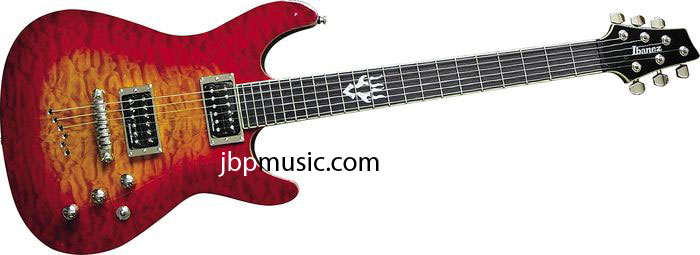 Ibanez SZ520QM Electric Guitar Review
Playability:
Ibanez SZ520QM Electric Guitar Review
Playability: Several things strike you immediately when you first pick up and play the SZ520. The neck is a dream – and lacks a big heel. The staggered, string-through design rings with sustain. The body is very nicely balanced and is of medium weight. The fretboard is comfortable.
The neck on the SZ520 is nearly ideal for chord players, shredders, and slide playing. It strikes a nice, medium-width balance against just a deep-enough “C” shape to get a grip on it when you’re running up and down the neck. The neck back is painted to match the body, and has a nice, hard, smooth finish. The neck-to-body join is superb on this instrument – few electrics get anywhere close to this nice of a join. The heel-less feels fantastic when you’re flitting around above the 14th fret. I truly wish most Gibsons and Epis had this type of neck join on their electric guitars.
The body balance is above average, if not pretty close to excellent. After playing the SZ for several hours, you don’t feel like you’re struggling with an unruly animal. It just feels good where it is – especially since the weight is medium in the spectrum. A Fender Stratocaster is significantly lighter in
feel, and a Les Paul is a bit heavier in
feel.
The fretboard, string-spacing, and fret size are an interesting combination – almost unique when compared to the other manufacturer’s view on fretboards. The fretboard is subtly different from most any other instrument out there. For those who are familiar with Fenders: it is thinner than a Strat and wider than a Tele – very similar to the superb and underrated Fender TC-90. For you Gibson and Epi fans out there, the SZ is much more like an Epiphone SG with respect to its neck. The fretboard is extremely similar to the Epi G400s I’ve played.
Fingerstyle players or players who use a modified pick hand (like myself) will find the strings a bit close together. However, this is balanced out by overall comfort, and the ease of gripping chords.
In order to get great sounds out of the SZ in slide and chord/soloing, the strings had to be at least 10s with thicker middle strings (and better, 11s or 12s). Custom light and extra-light strings sound muddy and don’t tune well when applied to the SZ. Also, the tone and sustain are robbed with smaller-gauge strings. I tried 10s Fenders, several 10s GHSs, and even the venerable D’Addario XL110s on the SZ, and none of them sounded very good. I ended up settling between D’Addario XLs with a minimum 11 high E-string and Ernie Ball Power Slinky (11.14.18.28.38.48). The Ernie Ball Power Slinky strings sounded the best by far.
If you’re not going to slide on the SZ, you’ll still need to get some good calluses and stay with a set that is 11 and above. 12s were just too thick for me on this instrument – I had a hard time getting a good vibrato and smooth-transition string-bends with 12s.
The fretwork of the SZ I owned was superb in almost any respect. The frets are medium in overall size and height, and the ends were reasonably well-dressed. The nut was well-worked and had no issues at all.
Features: The Ibanez SZ520QM (QM stands for “quilted maple” cap) is a high-feature guitar made in Korea. It has a gorgeous quilted maple cap on a warm and medium-thick mahogany body. The tuners are OK (not great), but the neck inlay is beautiful (my guitar got the name “blue flame” because of its 12th fret inlay). The finish on the guitar is deep and lustrous.
The heel-less neck feature is worth mentioning again. Feel it for yourself – most folks will absolutely love it.
The binding is light-cream, and is superbly done. I only felt the “edge” of the binding in one or two places on the front of the body, and none on the neck.
The Duncan/Ibanez open-face humbuckers are a nice feature. They strike a nice balance between being able to play stronger, more assertive music – and music that is marginally mellower.
The string-end design is string through. The staggered string holes are of varied lengths from the bridge and its saddles. Unlike many string-throughs, there is no tailpiece – the strings feed directly from the bridge to the holes in the body.
The Gibralter III bridge makes intonation a fairly easy task, and is completely buzz-free. It is stud-mounted to the top of the guitar, so lots of sound emanates through the bridge very nicely into the guitar body.
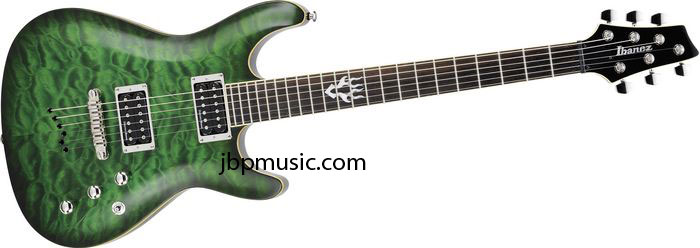 Sound:
Sound: The SZ520QM sounds wonderful. It has tons of sustain (although an Epi or Gibson Les Paul still have a longer and warmer sustain – the SZ is more like a set-neck SG in sound and sustain). The pickups and electronics are clean and noise-free. Sonically, the SZ is a good crossover guitar – from harder music to classic rock.
I found the pickups to be not as high on the output scale (sound-wise – I didn’t pull them and put them on a multi-meter) as you get with EMGs or more aggressive Seymour Duncan humbuckers. They are louder than my first Epiphone Les Paul’s original open-face humbuckers, but they are not as rich and creamy.
The pickup-selection-and-tone part of the guitar is pretty good. The SZ has the often-used Tone-Volume-Volume plus pickup switch hardware setup. With the SZ520QM, there is one master tone knob, the middle knob controls the bridge pickup volume, and the knob closest to the neck controls the volume of the neck pickup. The SZ also uses a fairly standard (but extremely well-made) pickup selector toggle switch.
Value: Value for the money is where the SZ is not quite a clear winner. I don’t think the guitar is terribly over-priced, but it is not a bargain in any sense. The Fender TC-90 (albeit with Black Dove P90 pickups) and the Epiphone Explorer and Epiphone Flying V are much better performers – yet they all cost less. A similarly-equipped Dean, Jackson, or Schecter is generally a better bargain for sound and price.
With that said, and in all fairness, the SZ520 does have a great feel, and does a decent enough job for the sound. I am a fan of Ibanez guitars, and there are many models that are great… I just think the SZ 520 should be a little lower in price. – or should have higher-end Seymour Duncans to bring up the value.
Wishes: Some nickel-covered and upgraded Seymour Duncans would be great (or, even better, some EMG HZ passive pickups, perhaps H4s). I really think Ibanez should choose to use some nice Grovers as tuners, or at least some locking tuner/locking nut offerings on this guitar.
Labels: acoustic guitar, bear, electric guitar, ibanez, review, set neck, shredder, sz, sz520, sz520QM
2006 Fender HSS Stratocaster (Strat) Review
Fender Standard HSS Stratocaster (“Fat Strat") Review
Electric guitar: Effervescent, visceral, emotional, and motivating…
Whether or not you start out as a Fender fan, the HSS Stratocaster is an extremely flexible instrument that is sonically diverse and very playable!
I was looking for an instrument that was comfortable and had a sonic range of sounds, was comfortable and affordable, and would compliment my Epiphones, Parker, and Fenders.
I love the
feel of a Stratocaster – the light weight, the wonderful ribcage cutaway, the warm rounded shoulder for the picking arm, and a simple, clean neck design.
The Fender Standard HSS Strat is all the things a Stratocaster is - but adds the crunchy, punchy sound (to the bell-tone Strat sounds of the neck and mid pickups) with its bridge humbucker.
At first, I wasn't really interested in the idea of a humbucker-enabled Stratocaster – Strats have always been “three singles" to me. However, after I played them many times over, I discovered just how sweet they are and how versatile they are.
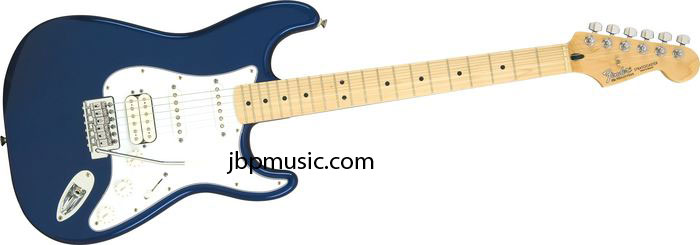 Quick Opinion:
Quick Opinion: The Standard HSS Strat is a dream to play. It has sounds that crunch like a Gibson and sounds that sing like an old Stratocaster. The 2006 (and later) Standard Strats (including the HSS) are deeply improved over previous years, and it shows. The new tremolo block, pickups, frets, and finishes are outstanding.
The HSS Standard MIM Stratocaster isn't currently in production (as of 10/2009), but you can see more about HSS Strats and get Free Shipping from GuitarCenter.com Playability:
Playability: The HSS Standard Stratocaster plays with great ease. It has wonderful string-bending capability, has a body shape that lets you forget that your pick arm is on a guitar body, and has a neck that is medium-broad for pretty good finger-picking capability. (In fact, if you're a finger-picking or hybrid-picking player, the Fender Strat neck and fretboard are among the most comfortable and easy-to-play on the market.)
As with most any Strat, the pickup selector switch is easy to use and is well within the pick hand's reach. Since the tonal variety of an HSS Strat is often more interesting and varied than a Standard three-single pickup Stratocaster, you may find yourself hitting the 5-way pickup selector switch quite often – varying your sound has never been so easy.
The subtle, non-gloss neck finish is great for when your hands are damp with sweat – your hands can still slide around the neck pretty well, but you can also get a good grip for those hard-to-finger chord shapes.
Features: The Fender Standard Fat Strat has all the features you'd expect from Fender's latest Stratocaster offerings. It has the famous Fender 5-way pickup switch, skunk-striped hard maple neck, a fantastic light-weight body, and extremely well-made electronics.
The pickguard is three-ply on most models (for example, White-Black-White). The back cavity cover is pretty standard for this type of Strat, generally a one-ply white cover. All the plastic parts are color-matched to the pickguard.
The tremolo setup is a standard three-spring mechanism, with string-through saddles and bridge. Tuning stability is average for a Stratocaster – although I have added a
tuning stabilizer (tremsetter) to my HSS for a boost in stability

.
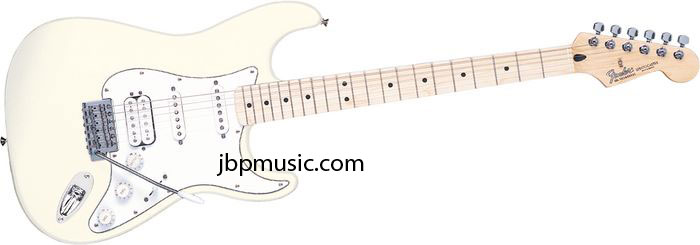 Sound:
Sound: Sound, sound, sound. That's the main reason for buying an HSS Fat Strat over a three-single Strat.
With the neck and mid single-coil pickups, you get the strong, bell-like tones you'd expect from a Stratocaster. In this respect, especially with the 2006 and later Strats, the HSS will not disappoint. These newer pickups seem stronger and clearer – and have somewhat less noise when playing through a strong tube amp.
With the Fender humbucker on the bridge, a whole new set of sounds come out of your Strat. This humbucker is actually pretty hot in output, and is really crunchy. It does blues, country, and hard rock
very well (but can be dialed back for super-smooth sounds of jazz, contemporary gospel).
The pickup switch configuration is as follows:
Position 1: (switch all the way towards the bridge) is full humbucker, no tone control in the sound. This is crunchy, can be dialed up loud, and is super-clean (good midranges, too).
Position 2: You get the front coil (split) of the bridge humbucker and the middle pickup in combination – the lead (closest to the input jack) tone control effects this combination. This position is very bright, and is louder than the standard Stratocaster bell-tone. This position is good for cut-through-the-band lead tones, but without all the crunch of the humbucker.
Position 3: This position opens up the middle pickup only, with the lead tone control affecting the sound. This sound is the traditional Stratocaster mid pickup sound – somewhat warmer than the bridge, but not as mellow as the neck.
Position 4: This position sets up the middle and neck single-coil pickups together, with the lead
and rhythm (middle) tone controls shaping the sound. Warm, but still lots of belltone.
Position 5: This is for the neck pickup only, and uses the rhythm tone control for sound shaping. This pickup position is the warmest of the single-coil sounds. By far, this pickup selection is the mellowest.
Value:This is an extremely high-value Stratocaster. It is worth more than its street price, probably in the $425 to $450 range in
actual value. You get lots of really nice options (humbucker, coil-split combination) to add to the versatility of your favorite Strat sound and feel.
Folks with a one-guitar budget who need/want to play lots of different styles of music should seriously consider this instrument as a front-runner for purchase consideration.
On my HSS Strat, the fret ends are cleanly set, the height of the frets is very good, and the intonation was pretty close (as set up by the factory). It didn't take very long for me to set the Strat's intonation to a very serviceable and easy-to-play tuning setup. The body finish is just right, no flaws. The neck is straight and is well-set. The standard Super 250 Fender Bullet Strings are wonderful.
Wishes: There isn't a lot to wish for with these Strats. I do wish it was offered with a V-shaped neck as an option, perhaps also with a tinted and V-shaped neck as an additional option – similar to the treatment on the 2006-> "50's Strat" issues coming from the MIM factories. I think all Strats should be offered with optional locking tuners (for those who don't know how to replace their own tuners).
Labels: electric guitar, fender, guitar, HSS, humbucker, single coil, strat, stratocaster
Gibson Les Paul Vintage Mahogany Review
Gibson USA Vintage Mahogany Les Paul
One of the guitars on my “to get” list is the Gibson USA Vintage Mahogany Les Paul (faded cherry). I've played several examples a great number of times over the past year or so… and although I could not purchase this one for myself (budget, budget, budget), I felt the need to express my view on this instrument. This instrument is a fundamental instrument that incorporates critical elements of a fabulous-sounding instrument. In its basic-ness, this particular Les Paul is all about sound delivery in a price-friendly Gibson package.
Tone folks will find the Les Paul Vintage Mahogany to be a monster… Folks whose budgets cannot achieve the heights of the Les Paul Standard, or even the Classic or Studio, will find this instrument to be a real bargain. Perhaps enough of a bargain to truly bring great Gibson-ness to many musicians’ sound libraries.
This is a fabulous instrument – stay tuned and I'll attempt to explain why it strikes me so well.
 Quick Opinion:
Quick Opinion: Grab one right now before they’re gone. Period. If I had the means, I would.
The wonderful Gibson Les Paul Vintage Mahogany is no longer in production :-(. But you can see more about the new Gibson LP Studios here at Guitarcenter.com Check out the new Raw Power LP and SG! Playability:
Playability: The Gibson Les Paul Vintage Mahogany is all Les Paul. It has the chunky 50's-style neck one expects from many Les Paul models. The neck is tapered in a subtle way, and the radius is extremely comfortable.
Another interesting aspect of the neck's playability is its consistency. It is even, smooth (if a little woody – like lots of natural-finish acoustic guitars, but not as wide), and very comfortable. As a person who truly likes the 60's neck profiles (and the slimmer Epiphone neck profiles), the Les Paul Vintage Mahogany was
different at first. However, after playing several examples over several months at my local, favorite Guitar Center, I adjusted to it. I am now more comfortable going between my Epi Les Paul and the Gibson.
The body’s weight seems to be really well-balanced. It doesn't feel as weighty on the shoulder as a traditional Les Paul – but it still retains that
singing, miles-of-sustain feel that makes Les Pauls so breathtakingly essential to many kinds of music. It plays like an old friend. It feels like an old friend, and is one of the most comfortable Gibson Les Pauls I’ve had the pleasure of playing.
Features: The features of the Gibson Les Paul Vintage Mahogany are varied and interesting. This particular Les Paul is a marriage of basic simplicity and killer electronics. The fretboard is very nice, the tuners are the (to me, essential) traditional green-tulip tuners. The body has no binding, and the top wood has the same feel and color of the back and neck.
This particular Les Paul may be a lower-priced Gibson, but it comes with a real, deluxe Gibson hardshell case. This is unusual, considering the fact that some of the other "worn-finished", less-expensive models only come with a gig bag (such as the Vee and the SG).
By far, one of the greatest values in the Vintage Les Paul Mahogany is its pickups. It comes with Burstbucker Pro humbucking pickups. I don't know how different the wiring is (as opposed to the Standard, Classic, or Studio), but the sound is absolutely awesome. The Burstbucker Pros, combined with the case, make this guitar feature rich – even though it isn’t a fancy Les Paul.
Sound: Sound, sound, sound, sound, and sound. WOW. Pick up an old or vintage Les Paul, close your eyes – pop it through some Marshalls or even a deluxe Twin Reverb, dial up the amp, and let loose. Now do the same with one of the Vintage Mahogany Les Pauls.
Listen... No matter if you can scream like Vai, cry and wail like Lang, or rip the souls of the audience into happy little pieces like Gilmour, or just play like a regular Jane or Joe, this instrument does not dissapoint. It takes that vintage-ness of the old PAFs, adds more output, and makes the dynamic range of the sound more (a good thing) complex and rich.
I’ve played several of these through a very wide variety of amplifiers, including nice Class-A Mesas, wide-rich VOXs, chunky Marshall stacks, cheap starter combos, Fenders, and some Kranks and Line 6s… this horse can not only trot, canter, or gallop – it is a true thoroughbred: it brings crunchy, singing, sustaining sound to any style, amp, pedal, or volume.
Sound, sound, sound, sound.
Value: Based on its sound, its case, its Burstbucker Pros, and its made-in-USA pedigree, this is absolutely worth much more than its street price. I’d put it at around $1k any day. The fact that you can buy it for much less makes it a 12-out-of-10 value any day of the week. If you've been thinking of going Gibson, or if you’re looking for that sweet, in-your-face rock. This guitar is a "jump on it now" opportunity. If you like warm, jazzy, neck-pickup sound that reminds you a little of B.B. King's ES-combined with some of that Jimmy Page roots-blues-rock, this is the one for you. You won’t be sorry for getting one of these. Go to your favorite get-in-trouble guitar store and play an example or two. If you don't have a git-box store nearby, check out your favorite online haunt and pick one up NOW.
Wishes: An optional 60's neck would be
fabulous (well, for me, anyway - sorry 50's fans).
Labels: electric guitar, gibson, gibson les paul, les paul, mahogany, usa, vintage
Parker P-36 Fly-cousin Electric Guitar Review
 Parker P-36 Guitar Review
Parker P-36 Guitar Review
I play instruments each day – with joy, I might add. Part of the real pleasure of making my music is my enjoyment of interacting with
different instruments. One of the BIG things that is important to me in an instrument is flexibility of sound.
Some instruments are very well made and don’t have any flexibility beyond the musician’s ability to alter sound. These instruments are important, and are the basis of any “sound library.” A superb oboe, trombone, piano, or trumpet can be played in many different sound-wise ways. But, some instruments allow for added flexibility. Electric guitars, basses, and other electric instruments can have built-in sound-shaping capability.
I recently went looking for a very playable, but very flexible guitar to add to my sounds. I had read about Parker guitars for quite some time – but I brought focus to Parkers because of some truly interesting capabilities. This review unfolds a bit about my decision to go with a Parker P-36.
Quick Opinion: The Parker P-36 is a pleasure to play. Its sonic capabilities are very wide, and the relative price is a bargain. The Parker P-36 is sort of akin to the superb set-neck and fabulous USA-made Parker Southern Nite Fly. As is often said, the apple doesn’t fall far from the tree, and the P-36 doesn’t disappoint.
The P-36 is feature-rich, flexible, playable, and fairly comfortable to play (comfortable even for playing long periods of time). The P-36 I picked had one nice little extra feature – the maple fretboard looks nicely flamed – a beautiful and nicely-done touch.
The P-36 appears to no longer in production, but you can see more information about Parkers and get Free Shipping on Parker guitars and basses at GuitarCenter.com Playability:
Playability: The P-36 has a comfortable radius on the fretboard, excellent fret height and width. The all-maple neck and fretboard is extremely accessible and feels "quick." For those of you who are big Fender fans, the P-36 neck is a comfortable marriage between the wider, more arced Strat neck and the narrower, quicker, flatter Tele neck. Overall, I’d give the neck a solid “A.” One distinct advantage of having this instrument is that switching among 6-string Fenders and the P-36 during a session is effortless and doesn’t cause the guitarist to have to re-think much of the scale reach in his/her head.
The interesting, trademark Parker Fly-shaped body of the P-36 allows for easy access to the whole fretboard - with middle-finger access to the upper 6 frets being fairly comfortable to those with longer fingers. After months of playing my P-36, I’ve found very few spots in the fretboard that require a funky hand shape to reach.
The body is nicely contoured. The overall thin-ness of the body, and the wonderful ribcage scoop behind the top horn make the guitar a favorite in our house. Just strap the P-36 on, and the guitar seems to fit against the body as if it was custom-made. Although the top lower-bout of the guitar body doesn’t taper for the pick-hand arm, the thinness and gentle shape of the top makes the lower bout fairly un-intrusive. To reiterate an important point, the guitar is well-balanced, and actually feels lighter than it actually is. The body’s Ash wood is a serious asset in this aspect of playability.
Features: The features of the P-36 is where it truly shines. The excellent marriage of magnetic standard-type coil pickups and piezo-bridge pickups give
huge combinations of sonic choices. Combined with the extra-flexible volume and tone control layout, a single P-36 can sound like many different guitars, each by just flipping the small piezo and/or magnetic pickup-select switch. Combined with the familiar neck-both-bridge magnetic selector switch, just a flip, dial, and click causes the P-36 to sound like a completely different instrument.
The P-35 has the fun and interesting headstock of the Fly clan, EXCELLENT genuine Grover 18:1 precise tuning machines, a lovely and comfortable maple fretboard, and an easily-accessible truss-rod adjustment wheel (you don’t have to remove the pickguard to adjust the rod – just use the notched wheel to loosen or tighten).
The tightly-glossed Ash body is done extremely well, and looks good to boot. I chose the blonde finish (what was it they said about blondes ;-)?). Overall, the P-36 is a very high-feature guitar for the money.
As an added bonus, the P-36 sells with a better-than average Parker Guitars gig bag.
Sound: Sound is a strong suit of the P-36. The two single coil pickups are very low-noise, but strong enough in output and aren’t gnarly. The sound from the magnetic pickups is on par or slightly better than comparable singles in guitars in the P-36’s price range. The Fishman piezo saddle pickups are crisp, even, and sound very good.
The piezo pickups add an almost acoustic quality to the sound of the P-36, when the pickup-type selector is set to piezo or piezo-and-magnetic. Although some amplifier types will cause the piezos to quack a bit under load, the piezos actually outperform almost all the bridge/saddle pickups I’ve tried.
The P-36’s sound has very good sustain for a bolt-on neck and moveable saddle guitar. The sound is very consistent throughout the life of the strings, and the tuning stability of the P-36 is well above average.
Value: I believe that the Parker P-36 is well-priced at its “street-price” level. It compares well with many instruments in the $600-$800 range – but with a boatload MORE features. Given a budget in this range, I feel as though I got a bargain – considering the sonic choices now in my sound palette. Since the P-36 is really in its own ballpark (more or less), it is difficult to compare it to the same price-range guitars from many excellent brands. That said, once you pick up a Parker P-36 and plug it in, you’ll be hard-pressed to walk out of the store without it.
Wishes: I have almost nothing to cite as concerns on the P-36. If I was designing the P-36, I think I would only ask for a little difference: a set neck. The bolt-on neck is fabulous, don’t get me wrong… I realize that one of the many feature upgrades going to a Southern Nite Fly is the Fly’s set neck. I also think that better availability of hard cases would also be nice.
Labels: electric guitar, fishman, guitar, p-36, p36, parker, piezo
Epiphone Les Paul Classic Quilt-Top Review
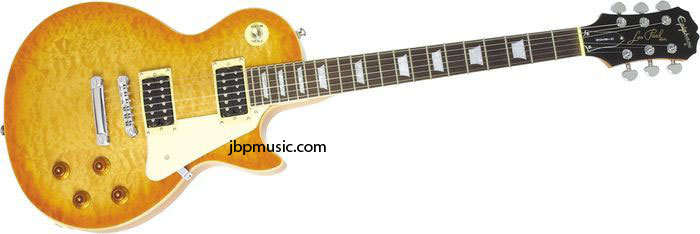 Epiphone Les Paul Classic Quilt Top Review
Epiphone Les Paul Classic Quilt Top Review
Over the years, there have been many guitars I have played and loved. One guitar, however, has been consistently my favorite to play - the Les Paul. I love Firebirds, Stratocasters, Telecasters, SGs, Ibanezs, PRSs and lists of others. But, time after time, I always come back to a Les Paul. The way they play, sound, feel, and look just says something to my soul. I know that Les Pauls aren't for everyone - no problem. They're just wonderful to
me.
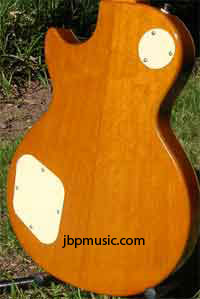 Quick Opinion:
Quick Opinion: The Epiphone version of the Les Paul Classic Quilt Top is a well-done rendition, with great features and decent sound. The guitar does not approach its Gibson cousin, but is definitely worth its price and then some.
The Epiphone Les Paul Classic is not currently in production, but you can find out more about Epiphone Les Paul guitars and get Free Shipping at GuitarCenter.com Playability:
Playability: In the world of Les Pauls, there are two main camps. Those that like thick necks and those that like more modern C-shaped necks. The Epiphone Les Paul's neck is much more comperable to a modern Tele or Strat than a 50s Les Paul. The neck is slightly less beefy than the 60s-neck Gibson Les Pauls, and significantly less beefy than the 50s-neck Gibson Les Pauls. If you're a modern Fender fan, the Epihpone will probably feel much more at home than the Gibson necks. If you're used to Ibanez electrics or modern ESP/LTDs, for example, you'll find the Epiphone very similar.

The neck plays like greased lightening, and is very comfortable from a grip point of view. The string spacing is excellent for most hands, and the string height is actually superb - right out of the box. In general, Les Pauls have a short-ish scale length (means, the length of the string is a little less than the average guitar). The shorter scale makes thicker strings a little more comfortable to play, and makes reasonable string-bending possible with 10s or 11s.
The balance of neck and body is good, and the fretboard is comfortable and smooth. Some may find the weight of Les Pauls (in general) a bit much to lug for hours at a time, but I think it is a reasonable trade-off for the MILES of sustain and depth of the guitar's sound.
Features The Epiphone Les Paul Classic Quilt top is very high in the features list arena. Were this a Gibson, the features of this guitar would be between a Les Paul Studio and a Les Paul Standard. The single-ply cream-colored binding is applied to the top edges and the fretboard. The back is pretty much a natural mahogany color, and the entire guitar is gloss finish (including the back of the neck). The quality of the smoothness of the finish is very good, although my particular guitar has a few blemishes underneath the top coat on the back (almost like a filler was applied to the wood, then finished over without coloring the filler).
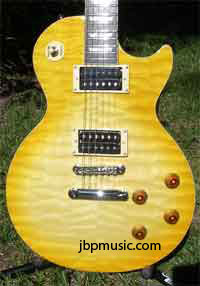
The Classic Quilt Top is actually a beautiful instrument, with mahogany body and quilted maple carved cap/top. The fretboard is a comfortable and nice quality rosewood, and the headstock overlay is fairly well done. The stop-bar tailpiece is standard Gibson stuff, as is the Tune-o-matic bridge. The guitar sports two tone knobs and two volume knobs, with one of each for each of the two pickups. My Classic came with superb, chrome full-sized Grover tuners. Epiphone appears to have made the switch from the jade-keystone-two-screw vintage tuners not long before my instrument was made - all the catalogs and internet sites still showed the guitar with the vintage tuners and not Grovers. (As an aside, I found some new Gibson-authorized Grover chrome tuners that have the keystone/tulip shape for the tuner buttons - and they were a direct replacement for the factory Grovers. I just like the keystone shape of the tuners better than the butterbean shape.)
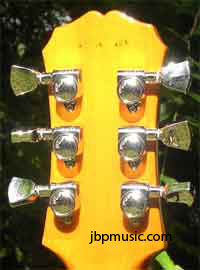
Overall, the Epi Classic is complete with features that compare favorably with other, nicer Les Pauls.
Sound: Sustain, sustain, clarity, clarity, and clarity. When you look up sustain in the dictionary, there's a picture of my Les Paul. Nuff said.
The pickups are a little on the low-output side (although still better than the Classic's less expensive siblings). When compared to Burstbuckers or Classic Gibson pickups, the edge, bite, and growl are significantly more tame with the Epi's pickups. But to put them in real perspective, they are more versatile, warmer, and more creamy than any other humbucker I've played in guitars in the same price range. Pickups are almost a matter of preference - when concerning their overall sound. Some like the visceral sound of EMGs, some like the mellow twangy-beefy of Fenders, and others like the true-blue broad-spectrum sound of Burstbuckers. The pickups in the Epi are most comperable to the Gibson humbuckers, but with less output and less tonal range. I realize I ramble on this part of the subject, but I think most will agree that you will always want
more pickup sound (unless you've bought a top-of-the-line Gibson/Fender/Etc.).
The sound of this particular Epi Les Paul is good for rock (almost all types), good and gutsy blues, electronica, and some forms of traditional metal.
Value: This is a $550 guitar in value (not 'retail',
'street'). This guitar is significantly nicer than the lower-end Epi Les Pauls, and is an excellent value for the money, the sustain, and the features.
Wishes: I love my Les Paul. Even when my budget will allow me to buy the Gibson Les Paul Standard of many a dream, my Epi will still get lots of play time and recording time.
However - The finish flaws on the back side could have been avoided. Also, as seems typical of many Chinese Epis, my guitar's lead wire solders were not very good. I had to re-solder most of the wiring into the pots before I could get the guitar to behave correctly (as was true of at least 6 other classics at my favorite guitar stores).
I do wish the pickups were covered with nickel covers. I do think the sound might change a bit with nickel covers - but to me, after looking at Les Pauls for so many years, nickel-covered pickups were traditional. Perhaps this model could be offered with more than one type of pickup system.
Labels: classic, electric guitar, epiphone, epiphone les paul, guitar, set neck
Ibanez AF-75D/AF75 Review - long-term impression
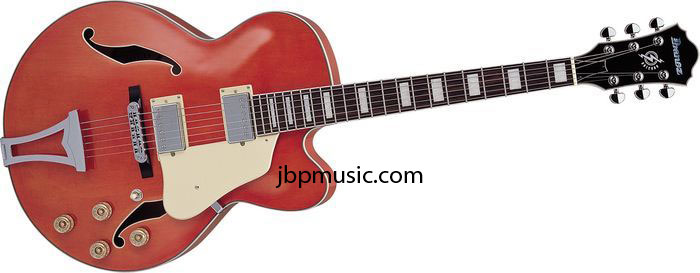
When I started playing guitar again (about a year and a half ago - after a 25-year break), one of my goals was to have different sounds with different types of guitars. One distinct sound for which I was looking was the jazzy/bluesy/open-body sound. In addition, I wanted the guitar to be able to rock 'n' roll.
A Second-Look: Ibanez AF75/AF75D long-term review
I visited my local guitar haunts and played just about every type and example of hollow- and semi-hollow-body electrics. My budget was $300 or less. To name a few, I played all of the Ibanez Artcore AF variants, several examples of the Epiphone Dot Studio, a few of the Carlo-Robelli/Brownsville types, and even a few used Gretschs and Gibsons (out of my budget range). I settled on a snappy and beautiful example of the Ibanez AF75D. Bear in mind that I played many examples of the same kind to get a feel for quality consistency and sound consistency. The one with which I came home was $319, and was a stunning example. I think I'd still like to have an Epiphone Dot Studio someday, but it was too far above my budget, and (frankly) I couldn't find an example with both a straight neck
and one with good electronics.
Quick Opinion: The Ibanez Artcore series are generally very well made. Most are made in China. The AF75D example I purchased ("Punkin") was exceptionally well made. The price was reasonable, and the sound quality is very much nicer than anything else in its price range. The guitar is chock full of features, has great parts, and plays like a dream.
I LOVE my AF75. Given the money in hand, I would buy another to put away for when I wear this one out.
See more info about the Ibanez AF75 here at GuitarCenter.com Playability:
Playability: The neck feels pretty quick and seems to be in the ballpark of Epis/Gibsons (short "feel" to the scale). The taper is just right, the fretboard was extremely nicely dressed and fitted, and the overall weight of the guitar is nicely light. After I fitted some Fender flatwound electric guitar strings (and substituted a plain 3rd instead of wrapped), the guitar played like a dream. The action adjusted to just the right height with little effort, and the reach of the single cutaway is very good - the top few frets of the low strings are a bit of a stretch.
Features The AF75 has two closed-cover humbuckers, binding on the neck, body, f-holes, and headstock. The tuners are very much like well-made grovers - very smooth and accurate. The trapeze and floating bridge combination makes for a wonderful and open sound (be careful, you must be prepared to do some measuring and intonation once you buy it - the position of the bridge is important to intonation). The three-way toggle is problem-free, and is fairly easy to reach. The individual volume and control knobs work fairly well in their purpose (they remind me of old Gibson Les Paul speed knobs). The body is laminated, but nicely shaped maple. The fit and finish overall is nearly as perfect as one could expect from a nicely-made guitar. The finish of the coloring is flawless - I really enjoy the "differentness" of the orange. The frets are medium, and are extremely well finished (I've played many $700+ guitars that don't have frets as nice as these).
Sound: The sound is open, airy, and wonderful. In any genre in which I play, this guitar can fit in. It is best for music from the 50s, 60s, and 70s - or Jazz or relaxed blues. It can play rock with the best of them, but the pickup output is too weak for hard rock/metal/thrash. In a loud band stage situation, the guitar can cause some feedback if placed too close to an amplifier (amazingly, this only happens in a few different melodic keys). The overall sound is crisp, clear, and refined. I'd rate the sound as something that is not as edgy as a Strat, but much mellower than a Les Paul or PRS.
Value: This is a $499 guitar in value (not 'retail',
'street'). The sound, quality of make, and appointments are top-notch for a bargain hollow/semi-hollow electric guitar, excellent. To get a better instrument, youíd have to go to a Gibson or a top-end Epiphone (Casino, etc.). This guitar is made in China, but you would have difficulty telling its origin from the excellent build quality. My local guitar stores now have them at $349 on the sticker. A case would be a good thing to get to protect your guitar - many different manufacturers make a case that works well with this guitar.
Wishes: Good instructions on bridge placement (for those who don't know how to adjust and place their bridge) would be essential. Stronger output from the humbuckers would be good, and a larger center-block to help keep feedback down would be good.
Labels: af-75, af-75d, af75d, electric guitar, hollowbody, ibanez
Squier (Fender) Affinity Telecaster Tele Review

Some time back, I was in search for a low-action, fast-neck guitar that could both
twang and growl. On top of the need for such a beast, I had a very small amount of cash with which to work. Since I was lucky enough to have a double-humbucking guitar at the time, I really just needed… a
Telecaster™. Before I was seriously blessed by my brother’s gift of a Blonde American Deluxe Telecaster™ (thanks, Bro!!!), I needed the use of a Tele™ for more than a year.
Enter the Squier™ Affinity Telecaster!
I went to my usual haunts, the Guitar Center and Sam Ash (my wife wishes I hadn’t found those places :-) - but she’s so wonderfully tolerant!). I played 6 examples of Squier Affinity Telecasters. I tried several different individuals – all of which had been whacked around pretty good as floor models. I was blown away at how this particular variety of guitar felt and sounded. The key here is that the two largest concerns I have when purchasing guitars are: 1) The sound the guitar can make through average amplifiers (I’m on a budget – no $2500 Buddhas here); and 2) The way the
guitar as a whole feels when I’m playing it.
I found one particular Squier Tele that I enjoyed a great deal, but it was not the color I wanted, and it had too many sales-floor-bang-ups. If I’m going to buy a bargain guitar, I really want the color I want and I don’t want one that has been whacked up by anyone but me or my son. I ended up settling on taking a chance with an online purchase from Musician’s Friend
Free Shipping and lots of information about the Squier by Fender Affinity Telecaster here at GuitarCenter.com
- I’m glad I did.
Quick Opinion: I generally like Fenders, but my budget was
really tight this time around.
Even the very modestly-priced $399 Mexican-made Fender Tele was way out of reach this time around.
That said, I was REALLY blown away by the quality, finish, playability and sound of this $169 Tele! If I closed my eyes and picked up the Fender and the Squier in succession, I would be hard pressed to tell the difference. The sound is better in the Fender, but not in terms of leaps and bounds. The neck and the pickups of the Fender are better (realistically), but the
playability of the Squier is fantastic!
Playability: The neck is a delightful satin-finish flat-ish "c"-ish shape hard maple two-piecer.
The frets are finished surprisingly well, with only a few end-burrs, and no inconsistency in fretwire height or finish. The frets could have been polished a little nicer – but you can do that yourself pretty easily with the right polishing paper/cloth. The scale is just right – medium. There are no buzzy frets on the example I purchased. The string height is very low, but only exhibits a little buzz – the buzz does not carry out into the sound through the pickups (only acoustically). I decided to leave the string height as-is – and replaced the factory strings (.09 Supers) with Stainless 3350s. The neck is really quick and the strings play out like hot butter! The only drawback is that the neck is a little thin for me (others may find it to be great, but I like to get a grip on my guitar necks).
The weight and balance of the guitar as a whole is excellent. It’s not overly neck-light (as are some Squier instruments), and the feel of the instrument’s construction is solid. The instrument is not as light as an Ash Tele, but won’t cramp your style in hours of spankin’ the fretboard plank. The hardware was finished flawlessly, and the electronics are clean enough.
Sound: Despite the slightly buzzy (normal for $169 guitars) pickups, the output of the pickups is surprisingly strong. If you were to put some Tex Mex Custom shops or some
GFS Alnico pups (I’m gonna get some fairly soon myself! They’re a bargain!) in this guitar, it would absolutely scream - for not a lot of bucks. I found that running this guitar through some interesting Line6 guitar models made this guitar really sing!
Value: This is a $249 guitar in value (not 'retail',
'street'). The sound, quality of make, and appointments are top-notch for a bargain electric guitar, excellent. To get a better instrument, you’d have to spend $399. This guitar is made in China, but you would have difficulty telling its origin from the excellent build quality. I have since seen the
Butterscotch Blonde version of this Tele – looks great!
Features: This is an excellently-designed instrument. It has the bits needed for daily use and for recording alike. The finish on the body is even and consistent. The neck finish is without remark, and the tuners are remarkably good for this price range… Overall, Telecasters are simple and genius at the same time.
A Small Issue at Delivery: When I received my Squier Tele, the nut had been cut incorrectly at the factory. The slots were not spaced very well, and the overall height of the nut was much too low. The 1st and 2nd strings had a bind-buzz from pinching at the nut, and the strings were way too close to the first and second fretwires. I called Musician’s Friend that day, and (as is very much usual), their customer assistance was excellent – they shipped out a
GraphTec replacement nut (an upgrade – I don’t have the tools to slot an OEM Fender nut) immediately at no charge. I replaced the nut on its arrival and have since become a
big fan of GraphTec’s guitar nuts. The bending is easier and the intonation stays put longer when I’m using one of their nuts. The nut was a little bit wide for the Tele’s neck, but not enough to get sideways about it – I don’t have a problem with the fact that it is not flush left-to-right.
Wishes: I'm glad to have the GraphTec nut, but I wish I hadn't had to deal with the problem. A tinted neck would really look nice!
Labels: affinity, electric guitar, fender, guitar, squier, tele, telecaster



























